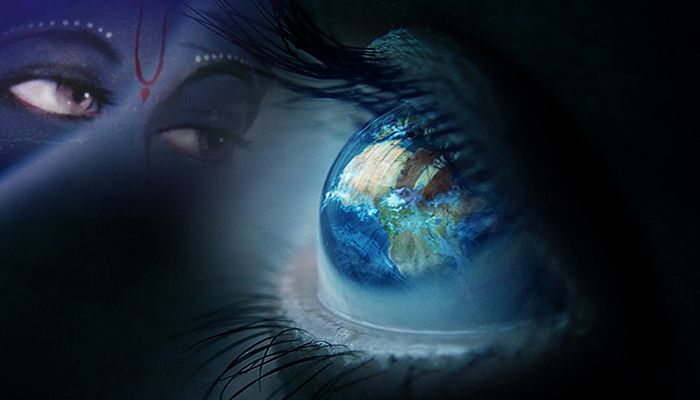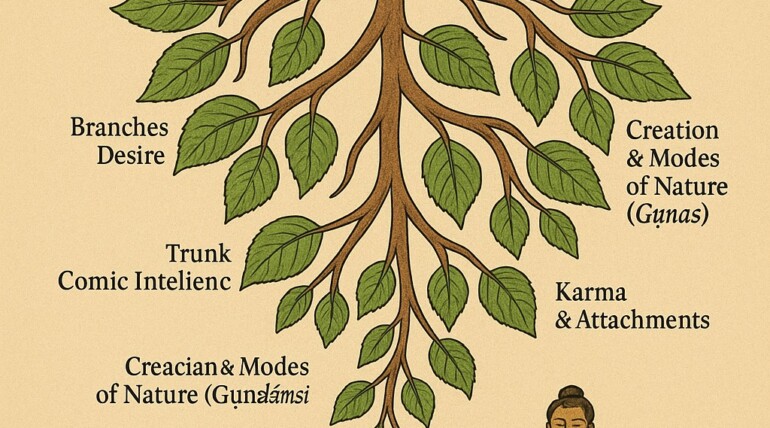🕉️ The Origin of the “I” and the Role of Māyā
From the Infinite to the Finite—and Back Again
🌟 The Mysterious Birth of the “I”
To free oneself from Māyā, one must begin at the very root of illusion—the origin of the ego, the sense of “I” that appears to separate us from the boundless Whole.
This sense of individuality—of being “someone,” separate from others and from the world—does not belong to the true Self. It is not innate to Brahman, the infinite, unchanging reality. Rather, it is a superimposition, an illusory reflection that arises when pure Consciousness seems to inhabit a body and a mind.
In reality, the Self (Ātman) is beyond form, gender, age, or name. It is not born, nor does it die. But when the Infinite begins to appear as finite, when it takes on the costume of limitation, the idea of “I” is born—not in truth, but in delusion.
“The ego is the shadow that appears when the Sun of Consciousness identifies with the body-mind.”
– Vedantic Insight
This ego-‘I’ is the very first veil cast by Māyā, the power that makes the unreal appear real. The Self, which is eternally the witness, forgets its witnessing nature and begins to identify—with actions, thoughts, names, and roles. It says:
“I am this body.”
“I am the doer.”
“I am the sufferer.”
“This is mine.”
Thus begins the play of duality.
🪞 Māyā: The Veil of Forgotten Infinity
Māyā is not evil, nor is it a cosmic error. It is the mysterious power (Shakti) of the Divine that enables the One to appear as many, the eternal to seem transient, and the unbound to seem constrained.
Māyā is not a substance, but a power of projection and concealment. It projects the world of name and form (nāma-rūpa), while concealing the non-dual Self beneath appearances. Through this double action, it gives rise to the dream of separation and the dance of samsāra.
- The One appears as subject and object.
- The real appears as unreal, and the unreal as real.
- Joy and sorrow alternate, each feeding the other.
- The mind becomes the battlefield of preferences and fears.
Yet even this confusion has a higher purpose. The Divine chooses to forget in order to rediscover itself. The soul takes countless births not because it is punished, but because it is on a sacred journey of remembering.
⚖️ Freedom Through Play: Līlā, Not Bondage
Embodiment is not a fall from grace. It is a manifestation of Divine Freedom. The Infinite, by its own will, contracts into a point, entering time and space to taste its own creation.
The scriptures refer to this as Līlā—the Divine Play.
This world is not a prison, but a vast playground, filled with color, contrast, and creative possibility. The One plays as the many. It loses itself in form, only to delight in the process of finding its way back.
Yet this game, like all games, must come to an end. At some point, the soul becomes weary of mere experience. It no longer seeks excitement, pleasure, or pain. It turns inward and asks:
“Who am I, really?”
“Is there something beyond all this changing?”
“Why do I suffer?”
“What was I before all these labels?”
That turning is the beginning of the return journey. And this return does not happen by default—it requires awareness.
🧘♂️ The Two Sacred Paths: Jñāna and Karma
To dissolve the ego and awaken to one’s true nature, the scriptures offer two principal disciplines:
🕯️ Jñāna Yoga – The Path of Self-Inquiry
The seeker asks:
“Who am I? What is this ‘I’ that claims ownership and agency?”
With persistent inquiry and guidance, the layers of false identity peel away. The seeker comes to see that the “I” they took to be real was just a thought, a reflection, a wave upon the ocean of Being. What remains is the Self—unchanging, self-luminous, whole.
🔱 Karma Yoga – The Path of Selfless Action
Here, the aspirant lives in the world, performing actions but without clinging to outcomes. They serve, they love, they work—but with a heart surrendered to the Divine. By acting without attachment, the ego weakens. By offering every action to the Supreme, the sense of doership dissolves.
Both these paths, though different in method, lead to the same destination: Freedom from Māyā and merging into the Self.
🌌 Returning to the Origin: From “I” to Infinity
When the “I” is no longer bound by body, thought, or role, it begins to fade like mist in the morning sun. What emerges is not a new identity—but the end of all identification.
- No more fear.
- No more seeking.
- No more clinging to “mine” and “yours.”
Only the pristine state of sat–cit–ānanda—pure being, pure awareness, pure bliss.
This is the home you never truly left. This is the silence behind all sound, the stillness beneath all movement, the truth beyond all appearances.
“As the river merges into the ocean and loses its name and form, so too the ego dissolves into Brahman and the game ends.”
– Upanishadic Wisdom
🔁 The Sacred Loop: Unity → Duality → Unity
This is the journey:
From Unity – the Infinite, non-dual Self
Through Duality – the play of Māyā, the arising of the “I”
Back to Unity – the return through knowledge and detachment
It is not a linear progression, but a sacred loop, a divine breath—inhaled as the One, exhaled as the many, inhaled again into the silence of Self.
🙏 Conclusion: From False “I” to True I Am
The ego is a momentary wave on the surface of eternity. It cries, clings, strives, and fears. But when seen in the light of truth, it is not destroyed—it is dissolved. What remains is not nothing, but Everything—the indivisible, infinite Self.
To be free of Māyā is to remember:
“I was never born. I never suffered. I only dreamed I was separate.”
- Awaken, O Seeker. The dream is ending.
- The Source is calling.
- And You are already That.
🕉️ God’s Journey Through 84 Lakh Species
The Divine Skating Game of Rasa Leela
The Supreme Being, eternal and indivisible, chooses—out of sheer joy and divine freedom—to enter into the dance of existence. He does this by manifesting Himself through 84 lakh species—from the smallest worm to the highest celestial beings. Each life form is like a temporary vehicle, a costume worn by the Infinite to taste the finite.
This cosmic play is not a mistake. It is not a punishment. It is what the sages call Rasa Leela—a divine sport of experience, diversity, and exploration.
🎭 The Metaphor of the Skater
Imagine a man at home, serene and whole. One day, he puts on skating rollers and steps out onto the street—not out of necessity, but out of playfulness. He skates, glides, tumbles, and learns. The road is rough at places and smooth at others. He feels the thrill of movement, the joy of momentum, the challenge of balance.
But after some time—whether due to boredom, exhaustion, or contentment—he removes the skates at the doorstep and returns home. He rests in the stillness of his natural state. Later, he may pick up a bicycle, a scooter, or a pair of hiking boots—each offering a new flavor of experience.
This is how God plays—taking up forms, entering into them, and leaving them when the experience is complete.
Bodies are divine play vehicles. Life is the road. Consciousness is the skater.
🌀 Each Birth, A New Vehicle
Every species is a new set of skates—a new way of perceiving, feeling, acting. From crawling to flying, from swimming to meditating, the Infinite tries on every perspective. These bodies are not permanent. They are rented costumes in a cosmic drama.
When a being dies, it is not an end. It is the shedding of one vehicle and the entry into another—each vehicle giving a slightly different perspective, function, and limitation. Over millions of lifetimes, the Supreme journeys through forms, collecting experiences in silence.
But in one particular form—the human form—something incredible happens.
🧠 The Human Birth: The Final Vehicle Before Home
After cycling through countless species, the soul evolves into the human body—a rare and sacred vehicle. It is the final portal before Home. What makes this body so special?
- It is not strength (animals have more).
- It is not speed or sensory sharpness (many species surpass us).
- It is the presence of Buddhi—the discriminating intellect.
- It is the power of self-awareness, of asking,
“Who am I? Why am I here? What is this game?”
This Buddhi gives humans the ability to reflect, to transcend, to wake up. Unlike other creatures, the human can understand the game of Māyā and choose to end the game—not by destruction, but by realization.
🧊 The Five Delusions: The Game’s Trap
Yet, this final phase is not easy. When the spark of God enters the human body, it is surrounded by five great delusions, which the other species do not face consciously. These are:
- The delusion of duality – thinking “I” and “God” are separate
- The delusion of doership – believing “I act, I suffer, I enjoy”
- The delusion of identification – mistaking the body, mind, or ego for the Self
- The delusion of transformation – thinking the world is a real change of God
- The delusion of reality – taking the dream-like world as absolutely real
These delusions are like layers of tinted glasses. They distort the pure light of consciousness and trap the soul in the cycle of karma, desire, and fear.
🔓 The Role of the “I”: From Illusion to Liberation
In the process of entering the body, the feeling of “I” arises. This “I” is not evil—it is a tool. But when misunderstood, it becomes a prison. It forms through the interaction of the three Gunas (Sattva, Rajas, Tamas), the five senses, and the mind. The soul begins to identify with these movements and forgets its true, unmoving center.
The very purpose of human life, therefore, is to see through this illusion, to understand that this “I” is not the real Self. It is only a reflection, a shadow of the Infinite pretending to be small.
“Just as the skater forgets that he is not the wheels but the man inside, the soul must remember: I am not the body—I am the One who wears it.”
🧘 The End of the Game: Realization and Return
When the human being, through Self-inquiry (Jnana Yoga) or selfless action (Karma Yoga), realizes that the game is not who they are, the dance slows. The craving ends. The doer disappears. What remains is the Witness—the original, unchanging Self.
At that moment, the skater removes the wheels, steps off the road, and enters Home—not as a new person, but as the original Being that was never lost.
This return is not an escape—it is a liberation into fullness. No more need for costumes. No more rides. Only silence, stillness, and bliss.
🌈 Conclusion: The Divine Dream and the Joy of Awakening
The journey from God to man and back to God is a sacred loop.
- The One becomes many.
- The many experience the dance of life.
- The many awaken to Oneness again.
The 84 lakh forms are not errors—they are explorations. But the human form is the sacred doorway through which the game of forgetting can end in remembrance.
Let us, as sparks of the Divine, recognize the dream and walk joyfully toward the Real.
🎵 “From skates to stillness, from street to sanctuary—from ‘I am this’ to ‘I am That’.”
Thus ends the play, and thus begins freedom.



